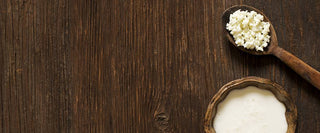Has your dermatologist prescribed a topical or oral antibiotic to help clear your acne? Along with benzyl peroxide and retinoids, antibiotics remain the front line of treatment for acne in teenagers and in adults.
Antibiotics are designed to tamp down P. acnes, the bacterial species that reside on the skin and are associated with acne. The problem? Antibiotics not only kill the bad bacteria but take out the good bacteria in the process.
While antibiotics may help with acne in the short term, their disruption to beneficial flora make them a lousy solution in the long-term.
Probiotics – A New Treatment for Sensitive Skin?
Although far removed from your skin, gut bacteria play a surprisingly important role in skin health. Studies dating back decades indicate that acne sufferers have an imbalanced gut microbiome. And, emerging research has shown that skin prone to acne can benefit from probiotics.
What can you do to get your skin and gut bacteria back in balance? Ask your dermatologist or skin care professional about the topical products she recommends.
Some professional skin care lines like MyBody include probiotics in their formulations to help rebalance the skin. Others like Epicuren, offer an Acidophilus Probiotic Facial Cream that is formulated with probiotics that inhibit negative bacterial growth and reduce inflammation. Their Bulgaricum Probiotic Mask Powder helps maintain balanced bacterial flora levels by competing with harmful, infection-causing bacteria.
Other mainstream brands that have products formulated with probiotics include Tula Skincare, Bioelements, Burt’s Bees, Andalou, and AOBiome.
In addition to using a topical probiotic, adopt these dietary and lifestyle practices to maintain a healthy blemish-free complexion.
Spring Clean Your Gut
You can discourage bacterial species that promote inflammation by cleaning up your diet. These bad actors thrive on sugar and saturated fat so eliminating processed, packaged foods that contain these ingredients is an important first step. Keep in mind that the number one source of added sugars is sweetened beverages.
You should also remove dietary toxins like sodium, caffeine and alcohol. Other foods such as dairy, wheat and gluten, peanuts, and soy, which promote an allergic reaction in certain individuals, should also be removed.
Instead, replace these foods with plenty of brightly colored fruits and vegetables. Plant based foods are nutritionally dense and help to promote beneficial bacterial species.
Want to move things along faster? Speed up the detox process by taking a cleansing supplement like Cleanse Digestive Care.
Cutting Empty Carbs & Dairy for Clear Skin
Pump Up the Prebiotic Fiber
If having a healthy gut leads to a clear complexion, then feeding the beneficial bacteria what they need should be your first priority. As it turns out, these beneficial organisms feast on a certain type of soluble fiber called prebiotic fiber.
A number of foods are an excellent source of prebiotic fiber like chicory root, Jerusalem artichoke, dandelion greens, garlic, leek, and onion. However, if you're like most of us, these vegetables are probably not high on your list of favorites. Foods like asparagus, raw wheat bran and bananas are more palatable but contain a very small amount of prebiotic fiber so you need to eat a large serving to get an appreciable amount of fiber.
That’s where taking a prebiotic fiber supplement comes in handy.
Feast on Fermented Foods
While prebiotics provide nourishment to the beneficial bacteria, eating foods that are good sources of probiotics, directly add back the organisms to your digestive tract.
Pickled or soured foods are fermented as part of the pickling or souring process which uses brine, vinegar, or another acid such as lemon juice. Sauerkraut, pickles and kimchi (Korean pickled cabbage) are examples of pickled vegetables that are a good source of probiotics.
Kick it up with Kefir
Kefir is a fermented dairy or non-dairy beverage that is loaded with beneficial bacteria. Brands like Lifeway offer low-fat versions that contain upwards of 12 bacterial species and up to 10 billion colony forming units (10 times the amount that live and active yogurt cultures contain). Lifeway’s Original Plain Kefir boasts 7 to 10 billion CFUs of 12 strains per one cup serving. You need to read labels as some brands can contain upwards of 20 grams of sugar per serving.
Repopulate With a Probiotic
Adding back beneficial species may be the easiest way to ensure that your gut is teaming with beneficial species. Select a broad spectrum formula like VitaMedica’s Daily Balance Probiotic-8 which contains 8 species of beneficial flora including those in the Lactobacillus and Bifidobacterium families. Each serving provides 8 billion CFUs and is enteric-coated so that the beneficial organisms are protected from harsh stomach acid.

